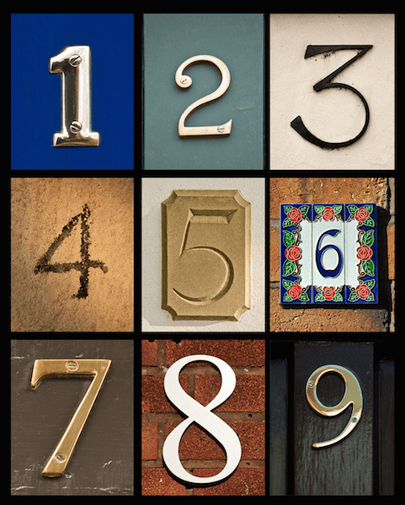
Integers, integers, integers (oh, my)! You've already read up on your basic ACT integers and now you're hankering to tackle the heavy hitters of the integer world. Want to know how to (quickly) find a list of prime numbers? Want to know how to manipulate and solve exponent problems? Root problems? Well look no further!
This will be your complete guide to advanced ACT integers, including prime numbers, exponents, absolute values, consecutive numbers, and roots—what they mean, as well as how to solve the more difficult integer questions that may show up on the ACT.
Typical Integer Questions on the ACT
First thing's first—there is, unfortunately, no “typical” integer question on the ACT. Integers cover such a wide variety of topics that the questions will be numerous and varied. And as such, there can be no clear template for a standard integer question.
However, this guide will walk you through several real ACT math examples on each integer topic in order to show you some of the many different kinds of integer questions the ACT may throw at you.
As a rule of thumb, you can tell when an ACT question requires you to use your integer techniques and skills when:
#1: The question specifically mentions integers (or consecutive integers)
It could be a word problem or even a geometry problem, but you will know that your answer must be in whole numbers (integers) when the question asks for one or more integers.
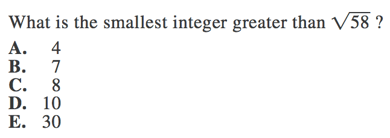
(We will go through the process of solving this question later in the guide)
#2: The question involves prime numbers
A prime number is a specific kind of integer, which we will discuss later in the guide. For now, know that any mention of prime numbers means it is an integer question.
A prime number a is squared and then added to a different prime number, b. Which of the following could be the final result?
- An even number
- An odd number
- A positive number
- I only
- II only
- III only
- I and III only
- I, II, and III
#3: The question involves multiplying or dividing bases and exponents
Exponents will always be a number that is positioned higher than the main (base) number:
$4^3$, $(y^5)^2$
You may be asked to find the values of exponents or find the new expression once you have multiplied or divided terms with exponents.

#4: The question uses perfect squares or asks you to reduce a root value
A root question will always involve the root sign: √
$√36$, $^3√8$
The ACT may ask you to reduce a root, or to find the square root of a perfect square (a number that is equal to an integer squared). You may also need to multiply two or more roots together.
We will go through these definitions as well as how all of these processes are done in the section on roots.

(We will go through the process of solving this question later in the guide)
(Note: A root question with perfect squares may involve fractions. For more information on this concept, look to our guide on fractions and ratios.)
#5: The question involves an absolute value equation (with integers)
Anything that is an absolute value will be bracketed with absolute value signs which look like this: | |
For example: $|-43|$ or $|z + 4|$
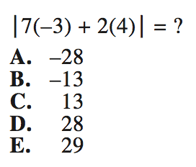
(We will go through how to solve this problem later in the guide)
Note: there are generally two different kinds of absolute value problems on the ACT—equations and inequalities.
About a quarter of the absolute value questions you come across will involve the use of inequalities (represented by > or <). If you are unfamiliar with inequalities, check out our guide to ACT inequalities.
The majority of absolute value questions on the ACT will involve a written equation, either using integers or variables. These should be fairly straightforward to solve once you learn the ins and outs of absolute values (and keep track of your negative signs!), all of which we will cover below.
We will, however, only be covering written absolute value equations in this guide. Absolute value questions with inequalities are covered in our guide to ACT inequalities.
We will go through all of these questions and topics throughout this guide in the order of greatest prevalence on the ACT.

We promise that your path to advanced integers will not take you a decade or more to get through (looking at you, Odysseus).
Exponents
Exponent questions will appear on every single ACT, and you'll likely see an exponent question at least twice per test. Whether you're being asked to multiply exponents, divide them, or take one exponent to another, you'll need to know your exponent rules and definitions.
An exponent indicates how many times a number (called a “base”) must be multiplied by itself.
So $3^2$ is the same thing as saying 3*3. And $3^4$ is the same thing as saying 3*3*3*3. Here, 3 is the base and 2 and 4 are the exponents.
You may also have a base to a negative exponent. This is the same thing as saying: 1 divided by the base to the positive exponent.
For example, 4-3 becomes $1/{4^3}$ => $1/64$
But how do you multiply or divide bases and exponents? Never fear! Below are the main exponent rules that will be helpful for you to know for the ACT.
Exponent Formulas:
Multiplying Numbers with Exponents:
$x^a * x^b = x^[a + b]$
(Note: the bases must be the same for this rule to apply)
Why is this true? Think about it using real numbers.
If you have $3^2 * 3^4$, you have:
(3*3)*(3*3*3*3)
If you count them, this give you 3 multiplied by itself 6 times, or $3^6$. So $3^2 * 3^4$ => $3^[2 + 4]$ => $3^6$.
$x^a*y^a=(xy)^a$
(Note: the exponents must be the same for this rule to apply)
Why is this true? Think about it using real numbers.
If you have $3^5*2^5$, you have:
(3*3*3*3*3)*(2*2*2*2*2) => (3*2)*(3*2)*(3*2)*(3*2)*(3*2)
So you have $(3*2)^5$, or $6^5$
If $3^x*4^y=12^x$, what is y in terms of x?
- ${1/2}x$
- x
- 2x
- x+2
- 4x
We can see here that the base of the final answer is 12 and $3 *4= 12$. We can also see that the final result, $12^x$, is taken to one of the original exponent values in the equation (x).
This means that the exponents must be equal, as only then can you multiply the bases and keep the exponent intact.
So our final answer is B, $y = x$
If you were uncertain about your answer, then plug in your own numbers for the variables.
Let's say that $x = 2$
$32 * 4y = 122$
$9 * 4y = 144$
$4y = 16$
$y = 2$
Since we said that $x = 2$ and we discovered that $y = 2$, then $x = y$.
So again, our answer is B, y = x
Dividing Exponents:
${x^a}/{x^b} = x^[a - b]$
(Note: the bases must be the same for this rule to apply)
Why is this true? Think about it using real numbers.
${3^6}/{3^4}$ can also be written as:
${(3 * 3 * 3 * 3 * 3 * 3)}/{(3 * 3 * 3 * 3)}$
If you cancel out your bottom 3s, you’re left with (3 * 3), or $3^2$
So ${3^6}/{3^4}$ => $3^[6 - 4]$ => $3^2$
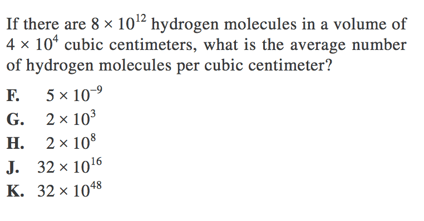
The above $(x * 10^y)$ is called "scientific notation" and is a method of writing either very large numbers or very small ones. You don't need to understand how it works in order to solve this problem, however. Just think of these as any other bases with exponents.
We have a certain number of hydrogen molecules and the dimensions of a box. We are looking for the number of molecules per one cubic centimeter, which means we must divide our hydrogen molecules by our volume. So:
$${8*10^12}/{4*10^4}$$
Take each component separately.
$8/4=2$, so we know our answer is either G or H. Now to complete it, we would say:
$10^12/10^4=10^[12−4]=10^8$
Now put the pieces together:
$2x10^8$
So our full and final answer is H, there are $2x10^8$ hydrogen molecules per cubic centimeter in the box.
Taking Exponents to Exponents:
$(x^a)^b=x^[a*b]$
Why is this true? Think about it using real numbers.
$(3^2)^4$ can also be written as:
(3*3)*(3*3)*(3*3)*(3*3)
If you count them, 3 is being multiplied by itself 8 times. So $(3^2)^4$=>$3^[2*4]$=>$3^8$
$(x^y)3=x^9$, what is the value of y?
- 2
- 3
- 6
- 10
- 12
Because exponents taken to exponents are multiplied together, our problem would look like:
$y*3=9$
$y=3$
So our final answer is B, 3.
Distributing Exponents:
$(x/y)^a = x^a/y^a$
Why is this true? Think about it using real numbers. $(3/4)^3$ can be written as $(3/4)(3/4)(3/4)=9/64$
You could also say
$3^3/4^3= 9/64$
$(xy)^z=x^z*y^z$
If you are taking a modified base to the power of an exponent, you must distribute that exponent across both the modifier and the base.
$(2x)^3$=>$2^3*x^3$

In this case, we are distributing our outer exponent across both pieces of the inner term. So:
$3^3=27$
And we can see that this is an exponent taken to an exponent problem, so we must multiply our exponents together.
$x^[3*3]=x^9$
This means our final answer is E, $27x^9$
And if you're uncertain whether you have found the right answer, you can always test it out using real numbers. Instead of using a variable, x, let us replace it with 2.
$(3x^3)^3$
$(3*2^3)^3$
$(3*8)^3$
$24^3$
13,824
Now test which answer matches 13,824. We'll save ourselves some time by testing E first.
$27x^9$
$27*2^9$
$27*512$
13,824
We have found the same answer, so we know for certain that E must be correct.
(Note: when distributing exponents, you may do so with multiplication or division—exponents do not distribute over addition or subtraction. $(x+y)^a$ is not $x^a+y^a$, for example)
Special Exponents:
It is common for the ACT to ask you what happens when you have an exponent of 0:
$x^0=1$ where x is any number except 0
(Why any number but 0? Well 0 to any power other than 0 equals 0, because $0^x=0$. And any other number to the power of 0 = 1. This makes $0^0$ undefined, as it could be both 0 and 1 according to these guidelines.)
Solving an Exponent Question:
Always remember that you can test out exponent rules with real numbers in the same way that we did in our examples above. If you are presented with $(x^3)^2$ and don’t know whether you are supposed to add or multiply your exponents, replace your x with a real number!
$(2^3)^2=(8)^2=64$
Now check if you are supposed to add or multiply your exponents.
$2^[2+3]=2^5=32$
$2^[3*2]=2^6=64$
So you know you’re supposed to multiply when exponents are taken to another exponent.
This also works if you are given something enormous, like $(x^19)^3$.
You don’t have to test it out with $2^19$! Just use smaller numbers like we did above to figure out the rules of exponents. Then, apply your newfound knowledge to the larger problem.

And exponents are down for the count. Instant KO!
Roots
Root questions are fairly common on the ACT, and they go hand-in-hand with exponents.
Why are roots related to exponents? Well, technically, roots are fractional exponents. You are likely most familiar with square roots, however, so you may have never heard a root expressed in terms of exponents before.
A square root asks the question: "What number needs to be multiplied by itself one time in order to equal the number under the root sign?"
So $√81=9$ because 9 must be multiplied by itself one time to equal 81.
In other words, $9^2=81$
Another way to write $√{81}$ is to say $^2√{81}$. The 2 at the top of the root sign indicates how many numbers (two numbers, both the same) are being multiplied together to become 81.
(Special note: you do not need the 2 on the root sign to indicate that the root is a square root. But you DO need the indicator for anything that is NOT a square root, like cube roots, etc.)
This means that $^3√27=3$ because three numbers, all of which are the same (3*3*3), are multiplied together to equal 27. Or $3^3=27$.
Fractional Exponents
If you have a number to a fractional exponent, it is just another way of asking you for a root.
So $4^{1/2}= √4$
To turn a fractional exponent into a root, the denominator becomes the value to which you take the root.
But what if you have a number other than 1 in the numerator?
$4^{2/3}$=>$^3√{4^2}$
The denominator becomes the value to which you take the root, and the numerator becomes the exponent to which you take the number under the root sign.
Distributing Roots
$√xy=√x*√y$
Just like with exponents, roots can be separated out.
So $√30$ => $√2*√15$, $√3*√10$, or $√5*√6$
$√x*2√13=2√39$. What is the value of x?
- 1
- 3
- 9
- 13
- 26
We know that we must multiply the numbers under the root signs when root expressions are multiplied together. So:
$x*13=39$
$x=3$
This means that our final answer is B, $x=3$ to get our final expression $2√39$
$√x*√y=√xy$
Because they can be separated, roots can also come together.
So $√5*√6$ => $√30$
Reducing Roots
It is common to encounter a problem with a mixed root, where you have an integer multiplied by a root (for example, $4√3$).
Here, $4√3$ is reduced to its simplest form because the number under the root sign, 3, is prime (and therefore has no perfect squares). But let's say you had something like $3√18$ instead.
Now, $3√18$ is NOT as reduced as it can be. In order to reduce it, we must find out if there are any perfect squares that factor into 18. If there are, then we can take them out from under the root sign.
(Note: if there is more than one perfect square that can factor into your number under the root sign, use the largest one.)
18 has several factor pairs. These are:
$1*18$
$2*9$
$3*6$
Well, 9 is a perfect square because $3*3=9$. That means that $√9=3$.
This means that we can take 9 out from under the root sign. Why? Because we know that $√{xy}=√x*√y$.
So $√{18}=√2*√9$. And $√9=3$. So 9 can come out from under the root sign and be replaced by 3 instead. $√2$ is as reduced as we can make it, since it is a prime number.
We are left with $3√2$ as the most reduced form of $√18$
(Note: you can test to see if this is true on most calculators. $√18=4.2426$ and $3*√2=3*1.4142=4.2426$. The two expressions are identical.)
We are still not done, however. We wanted to originally change $3√18$ to its most reduced form. So far we have found the most reduced expression of $√18$, so now we must multiply them together.
$3√18=3*3√2$
$9√2$
So our final answer is $9√2$, this is the most reduced form of $3√{18}$.

You've rooted out your answers, you've gotten to the root of the problem, you've touched up those roots....
Absolute Values
Absolute values are quite common on the ACT. You should expect to see at least one question on absolute values per test.
An absolute value is a representation of distance along a number line, forward or backwards. This means that an absolute value equation will always have two solutions.
It also means that whatever is in the absolute value sign will be positive, as it represents distance along a number line and there is no such thing as a negative distance.
An equation $|x+4|=12$, has two solutions:
$x=8$
$x=−16$
Why -16? Well $−16+4=−12$ and, because it is an absolute value (and therefore a distance), the final answer becomes positive. So $|−12|=12$
When you are presented with an absolute value, instead of doing the math in your head to find the negative and positive solution, you can instead rewrite the equation into two different equations.
When presented with the above equation $|x+4|=12$, take away the absolute value sign and transform it into two equations—one with a positive solution and one with a negative solution.
So $|x+4|=12$ becomes:
$x+4=12$ AND $x+4=−12$
Solve for x
$x=8$ and $x=−16$
Now let's look at our absolute value problem from earlier:
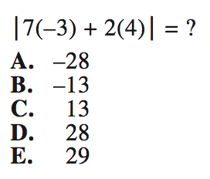 As you can see, this absolute value problem is fairly straightforward. Its only potential pitfalls are its parentheses and negatives, so we need to be sure to be careful with them.
As you can see, this absolute value problem is fairly straightforward. Its only potential pitfalls are its parentheses and negatives, so we need to be sure to be careful with them.
Solve the problem inside the absolute value sign first and then use the absolute value signs to make our final answer positive. (By process of elimination, we can already get rid of answer choices A and B, as we know that an absolute value cannot be negative.)
$|7(−3)+2(4)|$
$|−21+8|$
$|−13|$
We have solved our problem. But we know that −13 is inside an absolute value sign, which means it must be positive.
So our final answer is C, 13.
 Absolutely fabulous absolute values are absolutely solvable. I promise this absolutely.
Absolutely fabulous absolute values are absolutely solvable. I promise this absolutely.
Consecutive Numbers
Questions about consecutive numbers may or may not show up on your ACT. If they appear, it will be for a maximum of one question. Regardless, they are still an important concept for you to understand.
Consecutive numbers are numbers that go continuously along the number line with a set distance between each number.
So an example of positive, consecutive numbers would be: 5, 6, 7, 8, 9
An example of negative, consecutive numbers would be: -9, -8, -7, -6, -5
(Notice how the negative integers go from greatest to least—if you remember the basic guide to ACT integers, this is because of how they lie on the number line in relation to 0)
You can write unknown consecutive numbers out algebraically by assigning the first in the series a variable, x, and then continuing the sequence of adding 1 to each additional number.
The sum of five positive, consecutive integers is 115. What is the first of these integers?
- 21
- 22
- 23
- 24
- 25
If x is our first, unknown, integer in the sequence, so you can write all four numbers as:
$x+(x+1)+(x+2)+(x+3)+(x+4)=115$
$5x+10=115$
$5x=105$
$x=21$
So x is our first number in the sequence and $x=21$:
This means our final answer is A, the first number in our sequence is 21.
(Note: always pay attention to what number they want you to find! If they had asked for the median number in the sequence, you would have had to continue the problem with $x=21$, $x+2=$median, $23=$median.)
You may also be asked to find consecutive even or consecutive odd integers. This is the same as consecutive integers, only they are going up every other number instead of every number. This means there is a difference of two units between each number in the sequence instead of 1.
An example of positive, consecutive even integers: 10, 12, 14, 16, 18
An example of positive, consecutive odd integers: 17, 19, 21, 23, 25
Both consecutive even or consecutive odd integers can be written out in sequence as:
$x,x+2,x+4,x+6$, etc. No matter if the beginning number is even or odd, the numbers in the sequence will always be two units apart.
What is the largest number in the sequence of four positive, consecutive odd integers whose sum is 160?
- 37
- 39
- 41
- 43
- 45
$x+(x+2)+(x+4)+(x+6)=160$
$4x+12=160$
$4x=148$
$x=37$
So the first number in the sequence is 37. This means the full sequence is:
37, 39, 41, 43
Our final answer is D, the largest number in the sequence is 43 (x+6).

When consecutive numbers make all the difference.
Remainders
Questions involving remainders are rare on the ACT, but they still show up often enough that you should be aware of them.
A remainder is the amount left over when two numbers do not divide evenly. If you divide 18 by 6, you will not have any remainder (your remainder will be zero). But if you divide 19 by 6, you will have a remainder of 1, because there is 1 left over.
You can think of the division as $19/6 = 3{1/6}$. That extra 1 is left over.
Most of you probably haven’t worked with integer remainders since elementary school, as most higher level math classes and questions use decimals to express the remaining amount after a division (for the above example, $19/6 = 3$ remainder 1 or 3.167). But you may still come across the occasional remainder question on the ACT.
How many integers between 10 and 40, inclusive, can be divided by 3 with a remainder of zero?
- 9
- 10
- 12
- 15
- 18
Now, we know that when a division problem results in a remainder of zero, that means the numbers divide evenly. $9/3 =3$ remainder 0, for example. So we are looking for all the numbers between 10 and 40 that are evenly divisible by 3.
There are two ways we can do this—by listing the numbers out by hand or by taking the difference of 40 and 10 and dividing that difference by 3. That quotient (answer to a division problem) rounded to the nearest integer will be the number of integers divisible by 3.
Let's try the first technique first and list out all the numbers divisible by 3 between 10 and 40, inclusive.
The first integer after 10 to be evenly divisible by 3 is 12. After that, we can just add 3 to every number until we either hit 40 or go beyond 40.
12, 15, 18, 21, 24, 27, 30, 33, 36, 39
If we count all the numbers more than 10 and less than 40 in our list, we wind up with 10 integers that can be divided by 3 with a remainder of zero.
This means our final answer is B, 10.
Alternatively, we could use our second technique.
$40−10=30$
$30/3$
$=10$
Again, our answer is B, 10.
(Note: if the difference of the two numbers had NOT be divisible by 3, we would have taken the nearest rounded integer. For example, if we had been asked to find all the numbers between 10 and 50 that were evenly divisible by 3, we would have said:
$50−10=40$
$40/3$
=13.333
$13.333$, rounded = 13
So our final answer would have been 13. And you can always test this by hand if you do not feel confident with your answer.)
Prime Numbers
Prime numbers are relatively rare on the ACT, but that is not to say that they never show up at all. So be sure to understand what they are and how to find them.
A prime number is a number that is only divisible by two numbers—itself and 1.
For example, 13 is a prime number because $1*13$ is its only factor. (13 is not evenly divisible by 2, 3, 4, 5, 6, 7, 8, 9, 10, 11, or 12).
12 is NOT a prime number, because its factors are 1, 2, 3, 4, 6, and 12. It has more factors than just itself and 1.
1 is NOT a prime number, because its only factor is 1.
The only even prime number is 2. Standardized tests love to include the fact that 2 is a prime number as a way to subtly trick students who go too quickly through the test. If you assume that all prime numbers must be odd, then you may get a question on primes wrong.
A prime number x is squared and then added to a different prime number, y. Which of the following could be the final result?
- An even number
- An odd number
- A positive number
- I only
- II only
- III only
- I and III only
- I, II, and III
Now, this question relies on your knowledge of both number relationships and primes. You know that any number squared (the number times itself) will be an even number if the original number was even, and an odd number if the original number was odd. Why? Because an even * an even = an even, and an odd * an odd = an odd ($2*2=4$ & $3*3=9$).
Next, we are adding that square to another prime number. You’ll also remember that an even number + an odd number is odd, an odd number + an odd number is even, and an even number + an even number is even.
Knowing that 2 is a prime number, let’s replace x with 2. $2^2=4$. Now if y is a different prime number (as stipulated in the question), it must be odd, because the only even prime number is 2. So let’s say $y=5$.
$4+5=11$. So the end result is odd.
This means II is correct.
But what if both x and y were odd prime numbers? So let’s say that $x=3$ and $y=5$. So $3^2=9$ and 9+5=14$. So the end result is even.
This means I is correct.
Now, for option number III, our results show that it is possible to get a positive number result, since both our results were positive.
This means the final answer is E, I, II, and III
If you forgot that 2 was a prime number, you would have picked D, I and III only, because there would have been no possible way to get an odd number. Remembering that 2 is a prime number is the key to solving this question.
Another prime number question you may see on the ACT will ask you to identify how many prime numbers fall in a certain range of numbers.
How many prime numbers are between 20 and 40, inclusive?
- Three
- Four
- Five
- Six
- Seven
This might seem intimidating or time-consuming, but I promise you do NOT need to memorize a list of prime numbers.
First, eliminate all even numbers from the list, as you know the only even prime number is 2.
Next, eliminate all numbers that end in 5. Any number that ends is 5 or 0 is divisible by 5.
Now your list looks like this:
21, 23, 27, 29, 31, 33, 37, 39
This is much easier to work with, but we need to narrow it down further.
(You could start using your calculator here, or you can do this by hand.) A way to see if a number is divisible by 3 is to add the digits together. If that number is 3 or divisible by 3, then the final result is divisible by 3.
For example, the number 23 is NOT divisible by 3 because $2+3=5$, which is not divisible by 3. However 21 is divisible by 3 because $2+1=3$, which is divisible by 3.
So we can now eliminate 21 $(2+1=3)$, 27 $(2+7=9)$, 33 $(3+3=6)$, and 39 $(3+9=12)$ from the list.
We are left with 23, 29, 31, 37.
Now, to make sure you try every necessary potential factor, take the square root of the number you are trying to determine is prime. Any integer equal to or less than a number's square root could be a potential factor, but you do not have to try any numbers higher.
Why? Well let’s take 36 as an example. Its factors are:
1, 2, 3, 4, 6, 9, 12, 18, and 36. But now look at the factor pairings.
1 & 36
2 & 18
3 & 12
4 & 9
6 & 6
(9 & 4)
(12 & 3)
(18 & 2)
(36 & 1)
After you get past 6, the numbers repeat. If you test out 4, you will know that 9 goes evenly into your larger number—no need to actually test 9 just to get 4 again!
So all numbers less than or equal to a potential prime’s square root are the only potential factors you need to test. And, since we are dealing with potential primes, we only need to test odd integers equal to or less than the square root. Why? Because all multiples of even numbers will be even, and 2 is the only even prime number.
Going back to our list, we have 23, 29, 31, 37.
Well the closest square root to 23 and 29 is 5. We already know that neither 2 nor 3 nor 5 factor evenly into 23 or 29. You’re done. Both 23 and 29 must be prime. (Why didn't we test 4? Because all multiples of 4 are even, as an even * an even = an even.)
As for 31 and 37, the closest square root of these is 6. But because 6 is even, we don't need to test it. So we need only to test odd numbers less than six. And we already know that neither 2 nor 3 nor 5 factor evenly into 31 or 37.
So we are done. We have found all of our prime numbers.
So your final answer is B, there are four prime numbers (23, 29, 31, 37) between 20 and 40.
 A different kind of Prime.
A different kind of Prime.
Steps to Solving an ACT Integer Question
Because ACT integer questions are so numerous and varied, there is no set way to approach them that is entirely separate from approaching other kinds of ACT math questions. But there are a few techniques that will help you approach your ACT integer questions (and by extension, most questions on ACT math).
#1. Make sure the question requires an integer.
If the question does NOT specify that you are looking for an integer, then any number—including decimals and fractions—are fair game. Always read the question carefully to make sure you are on the right track.
#2. Use real numbers if you forget your integer rules.
Forget whether positive, even consecutive integers should be written as x+(x+1) or x+(x+2)? Test it out with real numbers!
6, 8, 10 are consecutive even integers. If x=6, 8=x+2, and 10=x+4.
This works for most all of your integer rules. Forget your exponent rules? Plug in real numbers! Forget whether an even * an even makes an even or an odd? Plug in real numbers!
#3. Keep your work organized.
Like with most ACT math questions, integer questions can seem more complex than they are, or will be presented to you in strange ways. Keep your work well organized and keep track of your values to make sure your answer is exactly what the question is asking for.

Got your list in order? Than let's get cracking!
Test Your Knowledge
1. 
2. 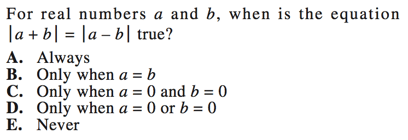
3.
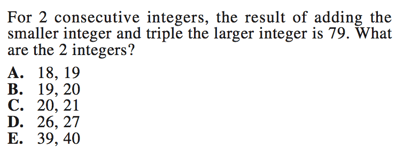 4.
4.
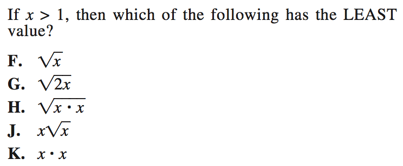 5.
5.
Answers: C, D, B, F, H
Answer Explanations:
1. We are tasked here with finding the smallest integer greater than $√58$. There are two ways to approach this—using a calculator or using our knowledge of perfect squares. Each will take about the same amount of time, so it's a matter of preference (and calculator ability).
If you plug $√58$ into your calculator, you'll wind up with 7.615. This means that 8 is the smallest integer greater than this (because 7.616 is not an integer).
Thus your final answer is C, 8.
Alternatively, you could use your knowledge of perfect squares.
$7^2=49$ and $8^2=64$
$√58$ is between these and larger than $√49$, so your closest integer larger than $√58$ would be 8.
Again, our answer is C, 8.
2. Here, we must find possible values for a and b such that $|a+b|=|a−b|$. It'll be fastest for us to look to the answers in order to test which ones are true. (For more information on how to plug in answers, check out our article on plugging in answers)
Answer choice A says this equation is "always" true, but we can see this is incorrect by plugging in some values for a and b. If $a=2$ and $b=4$, then $|a+b|=6$ and $|a−b|=|−2|=2$
6≠2, so answer choice A is wrong.
We can also see that answer choice B is wrong. Why? Because when a and b are equal, $|a−b|$ will equal 0, but $|a+b|$ will not.
If $a=2$ and $b=2$ then $|a+b|=4$ and $|a−b|=0$
$4≠0$
Now let's look at answer choice C. It's true that when $a=0$ and $b=0$ that $|a+b|=|a−b|$ because $0=0$. But is this the only time that the equation works? We're not sure yet, so let's not eliminate this answer for now.
So now let's try D. If $a=0$, but b=any other integer, does the equation work?
Let's say that $b=2$, so $|a+b|=|0+2|=2$ and $|a−b|=|0−2|=|−2|=2$
$2=2$
We can also see that the same would work when $b=0$
$a=2$ and $b=0$, so $|a+b|=|2+0|=2$ and $|a−b|=|2−0|=2$
$2=2$
So our final answer is D, the equation is true when either $a=0$, $b=0$, or both a and b equal 0.
3. We are told that we have two, unknown, consecutive integers. And the smaller integer plus triple the larger integer equals 79. So let's find our two integers by writing the proper equation.
If we call our smaller integer x, then our larger integer will be $x+1$. So:
$x+3(x+1)=79$
$x+3x+3=79$
$4x=76$
$x=19$
Because we isolated the x, and the x stood in place of our smaller integer, this means our smaller integer is 19. Our larger integer must therefore be 20. (We can even test this by plugging these answers back into the original problem: $19+3(20)=19+60=79$)
This means our final answer is B, 19 and 20.
4. We are being asked to find the smallest value of a number from several options. All of these options rely on our knowledge of roots, so let's examine them.
Option F is $√x$. This will be the square root of x (in other words, a number*itself=x.)
Option G says $√2x$. Well this will always be more than $√x$. Why? Because, the greater the number under the root sign, the greater the square root. Think of it in terms of real numbers.
$√9=3$ and $√16=4$. The larger the number under the root sign, the larger the square root.
This means that G will be larger than F, so we can cross G off the list.
Similarly, we can cross off H. Why? Because $√x*x$ will be even bigger than $2x$ and will thus have a larger number under the root sign and a larger square root than $√x$.
Option J will also be larger than option F because $√x$ will always be less than $√x$*another number larger than 1 (and the question specifically said that x>1.)
Remember it using real numbers. $√16$ (answer=4) will be less than $16√16$ (answer=64).
And finally, K will be more than $√x$ as well. Why? Because K is the square of x (in other words, $x*x=x^2$) and the square of a number will always be larger than that number's square root.
This means that our final answer is F, $√x$ is the least of all these terms.
5. Here, we are multiplying bases and exponents. We have ($2x^4y$) and we want to multiply it by ($3x^5y^8$). So let's multiply them piece by piece.
First, multiply your integers.
$2*3=6$
Next, multiply your x bases and their exponents. We know that we must add the exponents when multiplying two of the same base together.
$x^4*x^5=x^[4+5]=x^9$
Next, multiply your y bases and their exponents.
$y*y^8=y^[1+8]=y^9$
(Why is this $y^9$? Because y without an exponent is the same thing as saying $y^1$, so we needed to add that single exponent to the 8 from $y^8$.)
Put the pieces together and you have:
$6x^9y^9$
So our final answer is H, 6x9y9
 Now celebrate because you rocked those integers!
Now celebrate because you rocked those integers!
The Take-Aways
Integers and integer questions can be tricky for some students, as they often involve concepts not tested in high school level math classes (have you had reason to use remainders much outside of elementary school?). But most integer questions are much simpler than they appear.
If you know your way around exponents and you remember your definitions—integers, consecutive integers, absolute values, etc.—you’ll be able to solve most any ACT integer question that comes your way.
What’s Next?
You've taken on integers, both basic and advanced, and emerged victorious. Now that you’ve mastered these foundational topics of the ACT math, make sure you’ve got a solid grasp of all the math topics covered by the ACT math section, so that you can take on the ACT with confidence.
Find yourself running out of time on ACT math? Check out our article on how to keep from running out of time on the ACT math section before it's pencil's down.
Feeling overwhelmed? Start by figuring out your ideal score and work to improve little by little from there.
Already have pretty good scores and looking to get a perfect 36? Check out our article on how to get a perfect ACT math score written by a 36 ACT-scorer.
Want to improve your ACT score by 4 points?
Check out our best-in-class online ACT prep program. We guarantee your money back if you don't improve your ACT score by 4 points or more.
Our program is entirely online, and it customizes what you study to your strengths and weaknesses. If you liked this Math lesson, you'll love our program. Along with more detailed lessons, you'll get thousands of practice problems organized by individual skills so you learn most effectively. We'll also give you a step-by-step program to follow so you'll never be confused about what to study next.
Check out our 5-day free trial:
Have friends who also need help with test prep? Share this article!

Courtney scored in the 99th percentile on the SAT in high school and went on to graduate from Stanford University with a degree in Cultural and Social Anthropology. She is passionate about bringing education and the tools to succeed to students from all backgrounds and walks of life, as she believes open education is one of the great societal equalizers. She has years of tutoring experience and writes creative works in her free time.


































 Holly R.
Holly R.